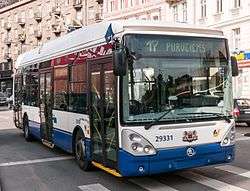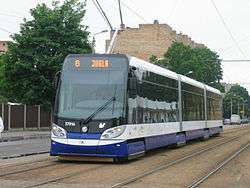Rīgas Satiksme
 | |
| Formation | 20 February 2003 |
|---|---|
| Type | Municipal Limited Liability Company |
| Legal status | Administered by RDSD |
| Purpose | Transit and Parking Authority |
| Headquarters | Vestienas iela 35, Latgale Suburb, Riga |
Area served | Greater Riga |
Chairperson | Leons Bemhens |
Mayor | Nils Ušakovs |
Parent organization | Rīgas Dome |
Staff | 4,100 (2017)[1] |
| Website | rigassatiksme.lv (English) |
Rīgas Satiksme is a municipally-owned public transportation and parking authority serving Riga, Latvia and the surrounding areas. The organization operates a network of road buses, trolleybuses, minibuses, and trams, while also administering paid parking services throughout the city. It currently employs roughly 4,100 staff and passengers completed.[2]
History
Rīgas Satiksme was founded February 20, 2003 as an umbrella organisation for the respective operators of trams, buses and trolleybuses in the city of Riga. Two years later, the separate operators of the different modes of public transport were merged and re-branded as Rīgas Satiksme, making it the largest provider of public transport in Riga.
Scandals
In early 2013 former advisor on transport affairs for Mayor of Riga and Rīgas Satiksme council deputy chairman Leonards Tenis was charged with repeated bribe taking in large amounts in the so-called Daimler bribery affair, where Daimler bribed Tenis and various other Riga City Council officials to secure winning the public transportation purchase tenders between 2002 and 2006.[3]
In 2013 police detained an employee of Rīgas Satiksme on the suspicion that he had raped multiple underage girls and filmed pornographic scenes with them, as well as coerced approximately 200 underage girls via social networking websites. He was accused of commiting 42 sexual crimes against 20 underage girls from 2009 to 2013.[4] In May 2015 another employee of Rīgas Satiksme was detained for gathering pornographic material of underage boys.[5][6]
On February 1, 2015, analytical news program "Nothing Personal" reported that Rīgas Satiksme may be involved in a fraud scheme related to the company's procurement of detergents and other cleaning aids in 2013 and 2014, when plain water was supplied instead of the ordered nanotechnological detergents. In response to the report Rīgas Satiksme set up a disciplinary investigative commission that performed an inquiry and reported not finding any violations in the procurement process.[7]
On December 14, 2017 four people were charged in what became infamously known as the "nanotechnology case" for a large-scale fraud causing 700 000 EUR loss to the company.[7][8] Among them was an official who was accused of "improper use of the service for gracious purposes, which has had serious consequences", while criminal proceedings had been initiated against two more officers, but Rīgas Satiksme was recognised as a victim in the case.[9] On July 4, 2018 the public prosecutor issued a warning to Riga City Council and Rīgas Satiksme for the procurement procedure of nanotechnology chemicals not complying with the requirements of the law.[10]
On October 1, 2018 police searched the offices of Rīgas Satiksme in relation to a launched criminal investigation over suspected large-scale fraud in the company.[11][12] Two days later the prosecutor's office confirmed that the searches were a part of a separate criminal case derived from the "nanotechnology case".[13]
Trolleybuses
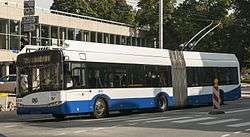
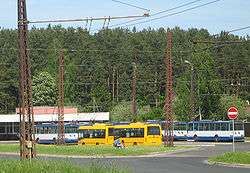
The first trolleybuses in Riga entered service in 1947, using a portion of the budget initially set aside for the new tramway, with the intention of moving slightly slower trams away from the city centre to allow for faster trolleybuses. The service was operated initially by Soviet-built units, although these were later replaced by Škoda vehicles brought in from Czechoslovakia. Conductors remained on trolleybuses for 5 years after they disappeared from the buses, with electronic ticket machines replacing them in 1975. Conductors were re-introduced on the trolleybus network in 1997. From 2007 new electric ticket machines were installed and conductors disappeared. In 2009 electronic ticket machines were replaced with e-tickets (E-talons).[14]
Trolleybus routes
| Number | Start point | End point |
|---|---|---|
| 1 | Pētersalas iela | Valmieras iela |
| 3 | Riga Central Market | Sarkandaugava |
| 5 | Daugava Stadium | Riga Clinical Hospital |
| 9 | Iļģuciems | Riga Central Station |
| 11 | Ieriķu iela | Riga Central Station |
| 12 | Šmerlis | Āgenskalna priedes |
| 13 | Ieriķu iela | Riga Central Market |
| 14 | Mežciems | Esplanade |
| 15 | Ķengarags | Latvian University |
| 16 | Šmerlis | Pļavnieki |
| 17 | Purvciems | Riga Central Station |
| 18 | Mežciems | Riga Central Station |
| 19 | Pētersalas iela | Ziepniekkalns |
| 22 | Katlakalna iela | E. Birznieka Upīša iela |
| 23 | Purvciems | Riga Central Station |
| 25 | Iļģuciems | Brīvības iela |
| 27 | Ziepniekkalns | Riga Central Station |
Livery
Trolleybuses are painted in the same blue and white colours as buses, although some carry advertising. Older trolleybuses still hold the old TTP two tone blue and white.
Trams
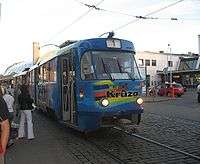
Trams have been in operation in Riga longer than any other mode of public transport, with the first horse-drawn trams entering service in 1882. In 1900 it was agreed that a number of electric tram lines would be built in the city, with the first electric trams starting operation in 1901.[15] Tram construction continued until the outbreak of World War I. Operation of the tramways remained largely unchanged until 1918 and the emergence for the first time of Latvia as an independent nation, when a Belgian company took over. This period of private ownership was deemed a failure, and the city authorities regained control of the tram network in 1931. World War II devastated Riga's public transport system, and it was gradually re-built to its current level.[15]
In 2002, Rīgas Vagonbūves Rūpnīca signed an agreement with the Mayor of Riga which would see the company replace the trams in Riga once their period of operation ended in 2010. The new trams would have offered enhanced comfort and safety, as well as would be far quieter than the city's current fleet of elderly ČKD Tatra units.
According to RVR they would have featured bright and spacious interiors and would have been 20-30% more power efficient than their predecessors. The new units were expected to be produced at a rate of 15-20 per year and would have resulted in a gradual phasing out of the Tatra tramcars.[16] Instead, 20 Škoda 15 T trams were built for Riga and entered service in spring 2010.
Tram lines
| Number | Start point | End point |
|---|---|---|
| 1 | Jugla | Imanta |
| 2 | Tapešu iela | Riga Central Market |
| 3 | Shopping Center "Dole" | Jugla |
| 5 | Iļģuciems | Mīlgrāvis |
| 7 | Shopping Center "Dole" | Ausekļa iela |
| 9 | Shopping Center "Dole" | A/S "Aldaris" |
| 10 | Bišumuiža | Riga Central Market |
| 11 | Mežaparks | Ausekļa iela |
Fares
A flat fare (applies from 1 February 2015) of 1.15 EUR per single journey (2.00 EUR, if bought from the driver) applies on all Rīgas Satiksme bus, tram and trolleybus services within the city boundaries. Fares on the regional bus routes vary depending on the journey destination.
The method of fare collection on public transport in Riga was by conductor until 2008 [17], and indeed this practice was widespread on buses operated by Rīgas Satiksme even after conductors were phased out in trams and trolleybuses.
See also
- Pasažieru Vilciens (Commuter rail & national passenger rail)
- Riga International Coach Terminal
References
- ↑ "employees".
- ↑ "2015 Ridership". 146.8 million rides in 2015.
- ↑ "Tenis officially charged in Daimler corruption affair in Latvia". The Baltic Course. February 8, 2013. Retrieved February 21, 2013.
- ↑ "RS worker accused of 42 sexual crimes partially admits his guilt". Baltic News Network. LETA. October 2, 2015. Retrieved December 3, 2015.
- ↑ "Second pedophile scandal involving Rigas satiksme". The Baltic Course. September 2, 2015. Retrieved December 3, 2015.
- ↑ "Rigas satiksme struck by second paedophilia scandal". Baltic News Network. LETA. September 2, 2015. Retrieved December 3, 2015.
- 1 2 "Charges to be brought against four persons Rigas Satiksme "nanotechnology" case". LETA. December 14, 2017. Retrieved December 20, 2017.
- ↑ "Four to be charged in Riga Transport 'nano water' case". Public broadcasting of Latvia. LETA. December 17, 2017. Retrieved December 20, 2017.
- ↑ "In the case of "Nano-water", Rīgas satiksme is recognized as a victim; Two other officers involved in the case". Naaju. September 9, 2018. Retrieved October 3, 2018.
- ↑ "In the case of the "Nano-water" case, the prosecutor warns the municipality of Riga and "Rīgas satiksme"". Naaju. July 4, 2018. Retrieved October 3, 2018.
- ↑ "Police search Rīga Transport offices over fraud". Public broadcasting of Latvia. LETA. October 1, 2018. Retrieved October 3, 2018.
- ↑ "Searches in Rigas Satiksme offices related with large scale fraud". The Baltic Times. LETA. October 1, 2018. Retrieved October 3, 2018.
- ↑ "Searches at Rigas Satiksme related to "nanowater affair"". Public broadcasting of Latvia. LETA. October 3, 2018. Retrieved October 3, 2018.
- ↑ "History of trolleybuses in Riga". Rīgas Satiksme. Retrieved 2007-06-16.
- 1 2 "1901. : History : About us : Rīgas Satiksme". Rīgas Satiksme. Retrieved 2013-07-13.
- ↑ "trams". RVR (in Russian). Archived from the original on 2011-07-22. Retrieved 2007-07-12.
- ↑ ""Rīgas satiksme" celebrates 10th anniversary!". Rīgas Satiksme. Retrieved 2018-06-18.
External links
- Official website (in English)
- Official website (in Latvian)
